Acknowledgements
The Summer 2025 edition of TWENTY-FIVE TREASURES would not have been possible without the generous support and participation of the lenders, artists, and the team at Paul Thiebaud Gallery.
My greatest thanks go to the various private collections who generously made works available for the exhibition, both as loans and those for sale. I also wish to thank the participating artists and Estates – Donna Brookman, Linda Fleming, Shawn HibmaCronan, the Estate of Ed Musante, and Andrew I. Wilson for agreeing to be part of the exhibition. My deepest gratitude also goes to Vivian Tong and Henry Weverka of Ruth Asawa Lanier, Inc., and Meg Partridge at the Imogen Cunningham Trust for their generosity and assistance with this project.
I give special thanks to the team at Paul Thiebaud Gallery – Colleen Casey, Matthew Miller, and Gregory Hemming – for all of their hard work and dedication to making this exhibition and this catalog a reality.
Lastly, I give my continued thanks to the family of Paul LeBaron Thiebaud (1960-2010) for their continued support and trust with the legacy of Paul Thiebaud Gallery and the Twenty-Five Treasures exhibition series.
Greg Flood, Director
July 2025


Shawn HibmaCronan (American, born 1985)
Ground Looper
2022
stainless steel, bicycle tires, and fiberglass
Eames chair, with a 3D printed bird skull
90 x 26 1/2 x 49 inches
Provenance
Acquired directly from the artist
Notes
Ground Looper was built in the spring of 2022 by HibmaCronan for SFMOMA’s Artist Soapbox Derby. HibmaCronan thinks of the piece as a fully realized, three-dimensional line-work sketch, which was designed to be as lightweight and raw as possible. Its structure consists of a triangulated space frame made entirely of 1/4” stainless steel bar, built around a vintage 1950s Herman Miller fiberglass Eames chair. The vehicle rolls on three 700c 3-spoked aluminum bicycle wheels and, in true soapbox derby form, is powered solely by gravity. The rider sits reclined and low to the ground, steering with foot pedals and braking using dedicated left and right hand brakes. With a single rear-wheel steering system, it demands total concentration to operate—an experience that inspired its name.
A “ground loop” refers to a phenomenon sometimes encountered by small aircraft with similar wheel configurations: a sudden, uncontrolled spin on the ground, typically during takeoff, landing, or taxiing. In the case of Ground Looper, initiating a turn at too high a speed causes the two fixed, angled front wheels to act as a pivot point, resulting in a looping skid driven by lateral momentum.
The 2022 event was the third time in 47 years that the Artist Soapbox Derby had taken place—the first two being in 1975 and 1978, also at San Francisco’s John McLaren Park. With much anticipation, thousands of spectators gathered to witness the return of this storied and imaginative competition.
HibmaCronan first learned about the earlier derbies while studying Sculpture and Furniture at California College of the Arts, which served as important early influences to his work. In many ways, Ground Looper stands as an homage to the threewheeled derby vehicles built by Don Potts, Ron Covell, and HibmaCronan’s longtime artistic hero, Michael Cooper.
HibmaCronan’s own sculptural practice—rooted in a love for car culture, furniture design, and thoughtful fabrication—has evolved into a body of vehicle sculptures that explore play, movement, mechanical inquiry, and the possibilities of public interaction.
On race day—April 10th, 2022—HibmaCronan arrived, only to be greeted by Michael Cooper himself, who was there to support Covell’s reentry of his 1978 vehicle. For HibmaCronan, presenting Ground Looper alongside the artists who inspired his path was a full-circle moment and a true honor.
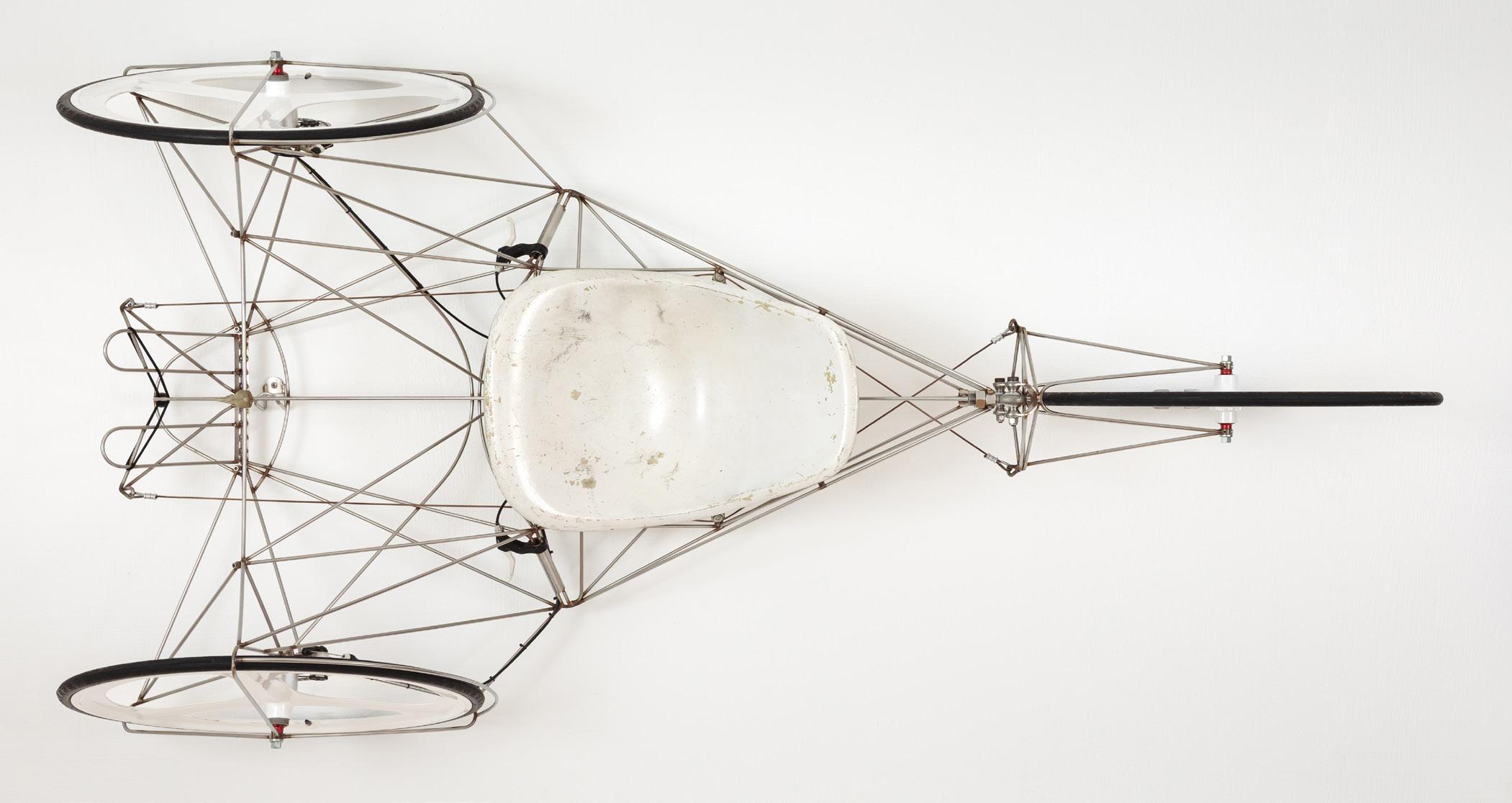



Harry Bowden (American, 1907-1965)
Horizontal
c.1938
oil on paper
8 x 12 inches
Provenance
Private Collection
Notes
Harry Bowden was a well-known American painter who worked in both abstraction and in realistic styles. This piece dates from the late 1930s, during a period when he was under the influence of renowned abstract painter Hans Hoffman, who was also a teacher to Jackson Pollock and Lee Krasner. While an abstract composition, it could be interpreted to be a rendering of an exhibition of early modernist sculptures in a gallery or museum. Bowden would later become a founding member of American Abstract Artists, a non-profit organization dedicated to promoting and fostering public understanding of abstract art.

Wayne Thiebaud (American, 1920-2021)
Cityscape
1993
oil on wooden box
7 5/8 x 4 x 3 inches
Provenance Artist’s Studio Private Collection Notes
Humble in size, Wayne Thiebaud’s Cityscape was painted in 1993 on the lid of a small jewelry box. Thiebaud painted more than one of these boxes during his life and gave them as gifts to close friends and members of his family. To make them, Thiebaud would visit local thrift stores to find the right box and then returned with them to his studio to imbue their surfaces with a small painting. Inside the box, would include messages and other objects as part of the gift. While the exact number of boxes painted by Thiebaud is not known, the number is very small.

Ruth Asawa (American, 1926-2013)
Untitled (S.636, Hanging Open-Window Form with Seven Tiers)
c.1950s, early looped steel wire
40 1/2 x 15 x 15 inches
Provenance
Artist’s studio
Private Collection, Oakland, CA
Thence by decent Notes
The fourth of seven children in a family of Japanese American farmers, Ruth Asawa has become a global star in the history of American art. Incarcerated with most of her family during World War II first at the Santa Anita Race Track, this traumatic experience proved to be a doubleedged sword. On the one hand, she and her family had lost their home, business, and were now forcibly confined for the duration of the war. On the other, for the first time she and her family could rest from the daily toil of hard work that comes with farming. Crucially, Asawa was also exposed to and studied with professional artists, the Japanese American Walt Disney animators who had also been incarcerated, and who had volunteered to teach drawing classes to the children. After Asawa and her family were transferred to the Rohwer Relocation Center in Arkansas, she continued studying drawing.
After the war ended, Asawa attended a teacher’s college in Milwaukee for three years, but left to go to Black Mountain College in North Carolina after the teacher’s college refused to assign her a required teaching practicum, citing lingering anti-Japanese racism and fears for her safety. At Black Mountain College, Asawa quickly became a favorite student of both Josef Albers and R. Buckminster Fuller, and she absorbed everything the school had to offer in both knowledge and experience. Another important early influence would be Merce Cunningham’s dance classes, which led Asawa to make drawings of biomorphic, lobed forms she called “dancers” Most critical to the development of her looped-wire sculptures, however, was a trip she took with her sister Chiyo to Toluca, Mexico, in 1947. There she learned to loop baskets out of wire from the village craftspeople. On leaving Black Mountain College in 1949, Asawa moved to San Francisco to be with her fiancé, Albert Lanier, who had also attended the college and had left before Ruth. By this time, Asawa had combined both form and materials to create her first hanging looped-wire sculptures.

Several of these first wire pieces have closed lobe forms, and defined interiors and exteriors. Their shapes, inspired by nature, recall the movements of dancers through space. Eventually, Asawa began to make “Open-Window” forms, where openings into the interiors of the sculptures appear in their wire skins. Untitled (S.636, Hanging Open-Window Form with Seven Tiers), is one of these works and was made in the early 1950s. Here the openings in the sculpture’s seven tiers form passages that appear and disappear as the viewer walks around the work. Their flaring edges flutter in stillness against the empty space around them, and recall the skirts of Folklorico dancers in Mexico.
Asawa had a very close friendship with photographer Imogen Cunningham (1883-1976), who lived just a few blocks away from Asawa and her family in San Francisco. Cunningham photographed Asawa, her studio, family, and her sculptures many times from the early 1950s to mid 1970s. Among the photographs she took was Ruth Asawa’s Sculptures in a Window, which depicts Untitled (S.636, Hanging Open-Window Form with Seven Tiers) on the right side of the image. Balanced against it on the left side of the composition is a group of three smaller hanging open-window form sculptures. Framing this group in the image is a window in Asawa’s studio, which is allowing the visible light to illuminate the four sculptures from behind. The idea of entrance and exit, inside and outside embodied in Asawa’s sculptures is emphasized by Cunningham’s composition, which at its basis explores the same principles.
Imogen Cunningham, Ruth Asawa’s Sculptures in Window, 1956. Gelatin Silver Print, 9 x 6 3/4 in. Fine Arts Museums of San Francisco, Gift of Ruth Asawa and Albert Lanier, 2006.114.8
Works Depicted by Ruth Asawa (L-R):
Untitled (S.633(a-c), Trio of Hanging Reversible, Open-Window Form Sculptures), c. 1956 looped sterling silver wire, Set of three (3) sculptures: Sculpture A: 28 x 7 1/4 x 7 1/4 inches, Sculpture B: 21 x 6 x 6 inches, Sculpture C: 15 1/2 x 6 1/4 x 6 inches,
Untitled (S.636, Hanging Open-Window Form with Seven Tiers), c.1950s, early looped steel wire, 40 1/2 x 15 x 15 inches



Giorgio Morandi (Italian, 1890-1964)
Natura Morta
1956
oil on canvas
7 7/8 x 10 1/4 inches
Provenance
Austin Desmond Fine Art, London, UK
Acquired from above, San Francisco, CA
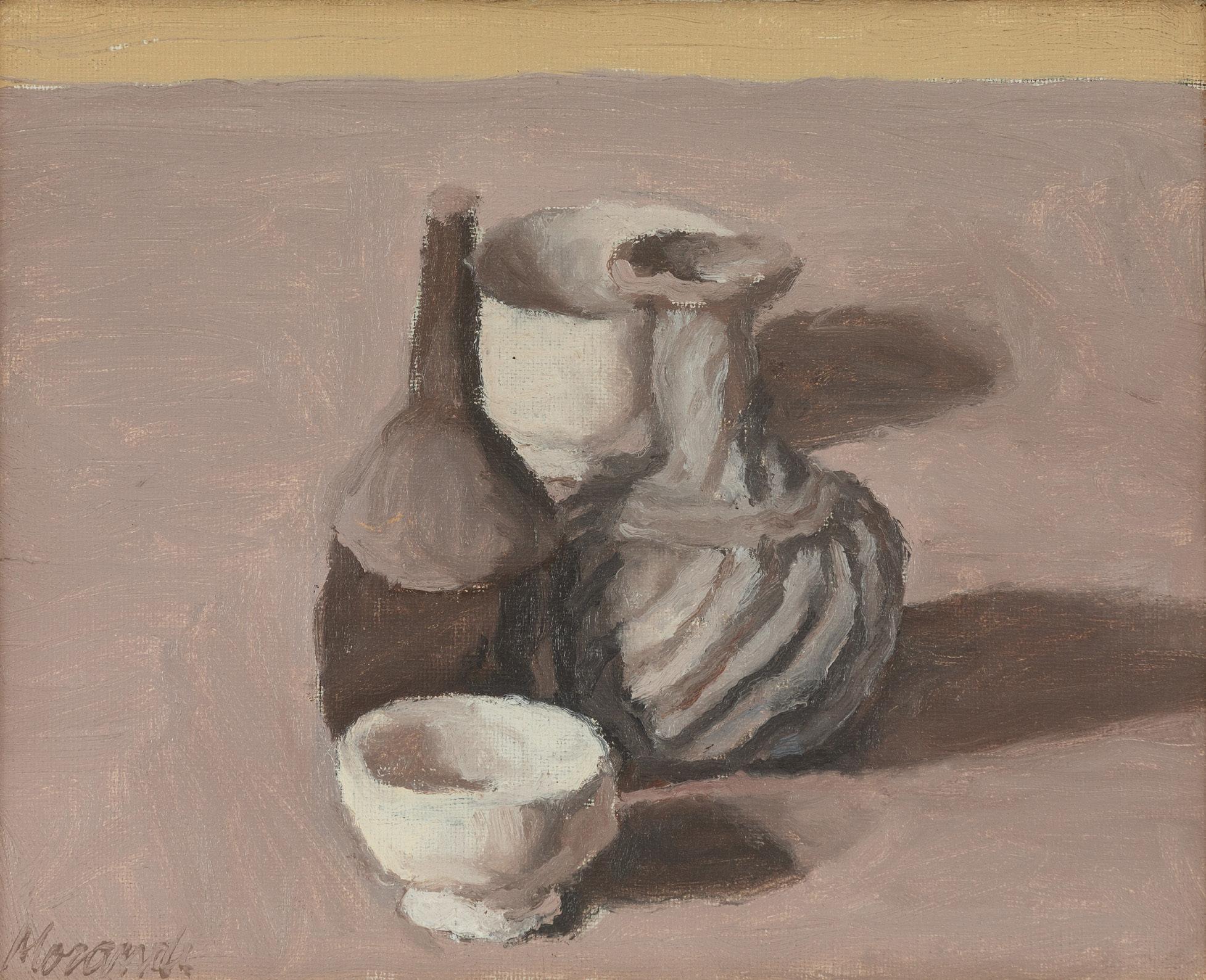
Anonymous (Kota, Rajputana, India)
Members of the Court of Ram Singh II
c.1830
ink on paper
14 1/8 x 10 1/4 inches
Provenance
Private Collection, Sacramento, CA
Notes
Maharaja Sawai Ram Singh II (28 September 1833 – 17 September 1880) was the Kachwaha Rajput ruler of the Jaipur kingdom from 1835 until 1880. He became the ruler of Jaipur at the age of 16 months after his father’s death. During his reign, he implemented various reforms, influenced by Western ideals and British preferences. He established new departments, reorganized the police force, and constructed roads to promote economic progress. Additionally, he aimed to transform Jaipur into a modern city, introducing schools, colleges, gas lights, and piped water supply. Ram Singh also focused on women’s education, building schools and hospitals for their empowerment. In addition to being a ruler, Ram Singh was also an avid photographer. This drawing sheet by an anonymous painter in the court of Ram Singh appears to be a study composition for one or more works.

Manuel Neri (American, 1930-2021)
Untitled (Standing Female Figure)
1987
plaster, burlap, acrylic, wood, styrofoam, and steel
70 3/4 x 26 1/4 x 17 1/2 inches
Provenance
Created at Sonoma State University as part of sculpture workshop Private Collection, California
Notes
Among the artists from the first- and second- generations of the Bay Area Figurative Movement of the 1950s and 1960s, there was only one artist who worked primarily in sculpture. Manuel Neri studied at the California School of Fine Arts (later known as the San Francisco Art Institute) in the 1950s under David Park, Elmer Bischoff, and James Weeks, and initially worked in painting. His friend Jay DeFeo, also a painter, returned in early 1953 from a trip to Europe and created a series of sculptures made of found wood scraps that were wrapped in various fabrics that had been dipped in plaster. When DeFeo moved from one studio to another later that year, she left some of them next to the door of her old studio. Wanting to bring them with her, DeFeo asker Neri to recover them and bring them to her new space. Neri did this for DeFeo and the experience of seeing and moving these works proved to be the catalyst that inspired Neri to explore plaster sculpture.1 Neri’s first pieces were abstracted slab forms, which he exhibited at Dilexi Gallery in 1958. Neri’s sculpture moved into the abstracted human figure shortly thereafter and worked in this manner for the rest of his career.
Untitled (Standing Female Figure) was created as part of a sculpture workshop demonstration that took place over a weekend in 1987 at Sonoma State University. Unusually for Neri’s works, a member of the audience was able to photograph the construction of the sculpture from beginning to end because it was created in public setting. We are publishing these newly discovered images for the first time alongside the completed work. The insights they provide into Neri’s working process are invaluable to both students and scholars alike.
1 Miller, Dana. “ Jay DeFeo: A Slow Curve”, Jay DeFeo: A Retrospective. New York: Whitney Museum of American Art and New Haven, CT: Yale University Press, 2012. pg. 18; Neri, Manuel. A Tribute to Jay DeFeo, University Art Museum, Berkeley, CA January 14, 1990; audio tape in the archives of the Jay DeFeo Trust, Berkeley, CA.

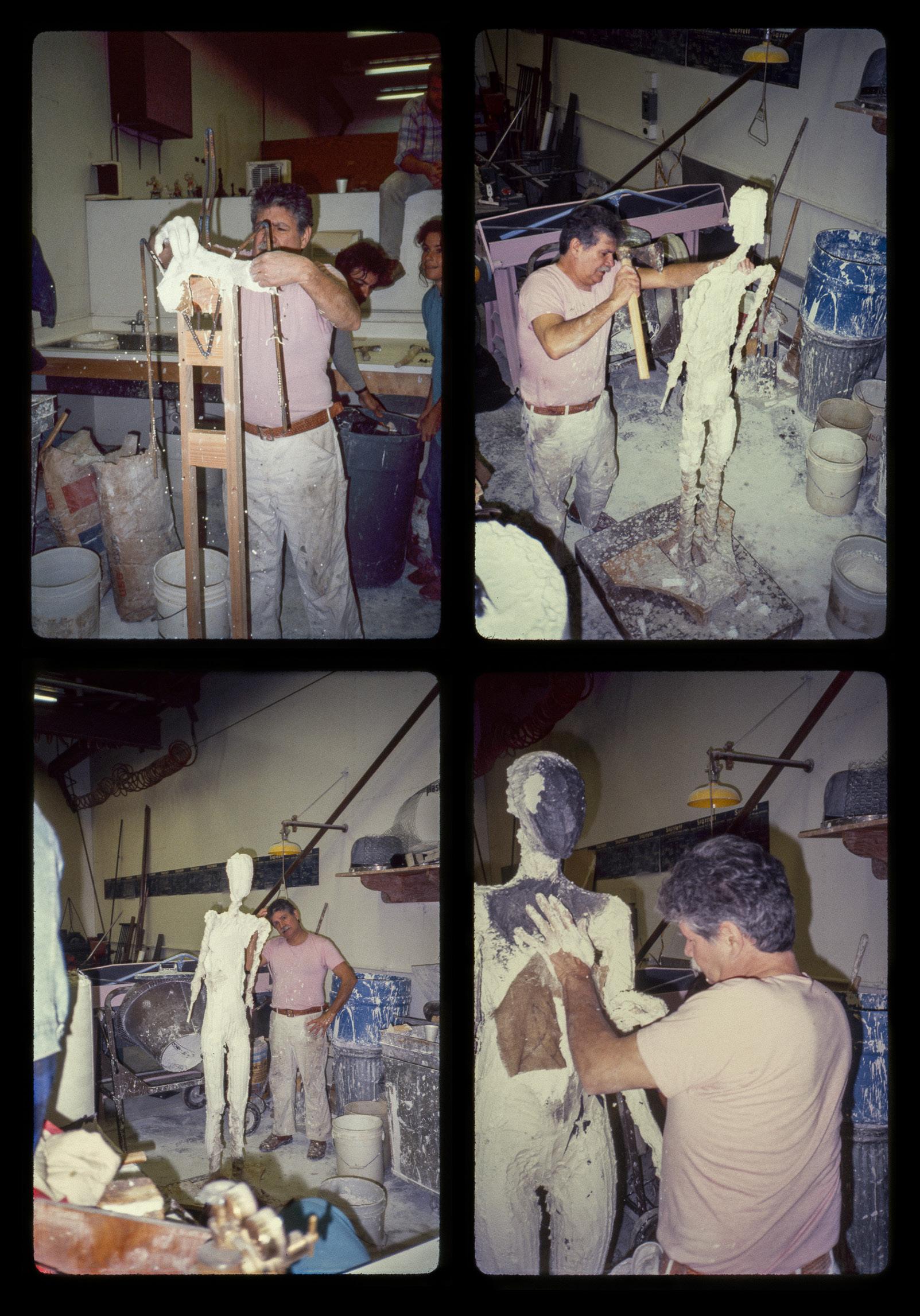



Franz Josef Kline (American, 1910-1962)
Sketchbook (from London)
n.d.
clothbound book
5 1/4 x 7 1/4 inches
Provenance
Collection of Allan Stone, New York
Estate of Allan Stone, New York
Rago Auctions: American + European Art, Friday June 26, 2020 (lot 00129)
Private Collection
Private Collection, Berkeley, CA
Notes
Born in Wilkes-Barre, Pennsylvania, Franz Josef Kline studied art at the Boston art Students League from 1931-1935, and also took classes from illustrator John H. Crosman. Searching for a richer educational experience, Kline moved to London in 1935 to study at Heatherley’s School of Fine Art. Kline would stay there three years and meet his future wife when she modeled for his life drawing class.
This small, partially filled sketchbook dates from Kline’s years in London. It bears his name and has the address of his London apartment inscribed on the inside cover. The pages are filled with pencil sketches of infant and toddler age children, with the exception of a young girl who could be around the age of ten. Also included are a page with two studies of adult heads and a partial cartoon of a Rolls Royce Phantom II in front of the Astor Hotel in New York on another. Given the context of how the pages are ordered in the sketchbook, one can infer that this was one of the last sketchbooks Kline started in London. He later carried it back with him to New York and added the cartoon as the last entry after his arrival in the States.
The identities of the children in the sketches are unknown. Given the subjects and the small scale of the notebook, it is unlikely that they were done as part of a class at Heatherley’s. Their casual, intimate nature suggests the subjects could be the children of close friends or were part of his new wife’s family.
Kline would not have his “breakthrough” moment into a style of abstraction he could call his own until 1949. After his return to New York, he worked in a loosely representational style until around 1945, when he began to explore abstraction through the use of simplified planes of color separated by bold line work. It is important to remember that while he is celebrated for his abstractions, Kline, like many of his peers in the Abstract Expressionist avant-garde, had their grounding and training in the traditions of American and European Realism.


Roy De Forest (American, 1930-2007)
Tropic of Capricorn
1999-2000
acrylic on canvas with sculptural appendage
84 x 90 1/2 x 8 inches
Provenance
Artist’s Studio
Imago Galleries, Palm Desert, CA
Private Collection, Palm Desert, CA
Notes
Celebrated for his folk-like landscape paintings full of dogs, birds, horses, and humans, Roy De Forest (1930-2007) has been recognized as one of the most original painters of his generation. De Forest began as an abstract painter while a student at the California School of Fine Arts (later known as the San Francisco Art Institute) and at San Francisco State University, where he completed his Master’s degree in 1956. He first showed at San Francisco’s East-West Gallery before moving over to the city’s legendary Dilexi Gallery in 1960. Around the time of his move to Dilexi, De Forest was working as an art handler at the San Francisco Museum of Art (now SFMOMA) and was inspired by looking at the backs of paintings to make a series of elaborate constructions that hang on the wall like paintings. This series would later inform the creation of his elaborately carved ornamental frames with sculpture that began appearing around 1980.
As the 1960’s progressed, De Forest’s purely abstract paintings first evolved to resemble highly textured aerial landscapes, that would later include the emergence of human faces, and other recognizable details. By the early 1970’s, however, these works yielded fully to the folk-like landscapes with traditional perspective that appeared. This celebrated body of mature work by De Forest would evolve in palette, and the addition of his elaborate frames, but the format and style remained consistent until his death in 2007.
Tropic of Capricorn (1999-2000) is a quintessential example of De Forest’s paintings from the later part of his career. While he never explicitly talked about the meanings and inspirations behind his works, what has always been clear is that he drew on not only art historical sources, but literature, science, and the events of his life. In this case, we know that De Forest had a long fascination with South America, having began a series of “rain forest” paintings in the late 1980s. (He would eventually make a trip to Chile in 2003 with the Oakland Museum Natural History Guild.) Here, De Forest has depicted a scene in a forest setting composed primarily of palm trees. Among them, De Forest has painted Western and indigenous figures, as well as dogs, birds, and totemic idols. The presence of the hybrid bird with a human head in the tree has been interpreted by curator Susan Landauer to be a harpy from Greek mythology1, and is one more example of De Forest’s blending of inspirations.
1 Landauer, Susan. Of Dogs and Other People: The Art of Roy De Forest. Oakland, CA: Oakland Museum of California in association with University of California Press, 2017, pg. 144.



David Gilhooly (American, 1943-2013)
Erotic Frog Wedding Cake #6
1979
glazed and painted earthenware
28 1/2 x 14 1/2 x 14 1/2 inches
Provenance
Artist’s Studio
Hansen Fuller Gallery, San Francisco, CA
Private Collection
Sotheby’s New York: 20th Century Decorative Arts; Saturday, March 31, 2007 (Lot 00285) sold
GLC Art Co. LLC; Gerard L. Cafesjian President
Los Angeles Modern Auctions: Modern Art and Design Auction; Sunday, May 23, 2010 (Lot 00342) bought in Estate of Gerard L. Cafesjian
Los Angeles Modern Auctions: Modern Art & Design Auction; Sunday, June 14, 2020 (Lot 00050) sold
Private Collection
Los Angeles Modern Auctions: California Design; Thursday, September 26, 2024 (Lot 00220) sold
Notes
David Gilhooly is famous in the world of American ceramics for his sculptures of frogs as food items, such as burger and ice creams, or as historic figures such as George Washington and Noah. Gilhooly was first a student of Robert Arneson at UC Davis and a faculty member at the university after graduating. In the early 1970s, Gilhooly developed the Frog Fred character persona in his ceramics and it became the defining signature of his career. Each of his pieces can be viewed as part of the comedic adventures of Fred Frog’s journey through the world. In the late 1970s, Gilhooly created a series of Erotic Frog Wedding Cakes, which were later shown at Fuller Goldeen Gallery in San Francisco. Standing atop each cake are Fred Frog and his bride in states of canoodling. In the case of Erotic Frog Wedding Cake #6, Fred and his bride are sitting on a large heart, symbolizing their love. Throughout the frosting along the sides of the cake ties, frogs cavort in a running frieze of priapic excitement. All of this lighthearted naughtiness is meant to inspire laughter and amusement in viewers, something we can all use more of in our daily lives.

Jaune Quick-To-See Smith
(American; Confederated Salish, Kootenai, and of Métis and Shoshone Descent, 1940-2025)
Four Directions
1994 photolithograph and linocut, ed. 26/200 44 1/2 x 30 inches
Provenance
Printed by Lawrence Lithography Workshop (Kansas); published by Greenpeace USA, Washington D.C. 871 Fine Arts, San Francisco, CA Clars Auctions, Oakland, CA; September 19, 2024 (Lot 5650) sold
Notes
Jaune Quick-to-See Smith was an important Native American artist who was an enrolled member of the Confederated Salish and Kootenai Tribes and was also of Métis and Shoshone descent. She was an educator, storyteller, art advocate, and political activist. Her work draws from a Native worldview and comments on American Indian identity, histories of oppression, and environmental issues. In its array of sketches, colors, and text, this work titled Four Directions seems to contain an entire system of beings and ideas. An infinitude of possible relationships emerges between the print’s details, including the child on a rocking horse near the bottom edge, disclaimers like “Do Not Microwave” and “Batteries not included,” and the bird perched on a leafy branch, rendered in thick black lines. In her artistic practice, Jaune Quick-to-See Smith interprets contemporary social and political issues “through the ideology of Native peoples.” This work’s title invokes a particular ideology which links each of the four directions to a different facet of life, such as a season of the year, time of day, and stage of human life. Published by the environmental nonprofit organization Greenpeace USA, the print tethers this worldview to activism by Smith and other Indigenous people.1
1 Online source: blockmuseum.emuseum.com/objects/371/four-directions?ctx=34a8f0b2972997af98f30d0f3d7a649e5f3ebccb&idx=0

Linda Fleming (American, born 1945)
Wave
2017
acrylic on laser cut plywood, edition 2 of 3 13 x 21 x 9 inches
Provenance
Acquired directly from the artist
Notes
Inspired by walks through nature, Linda Fleming extrapolates the topographies, phenomena, and patters she sees into the geometric shapes and lace-like flowing lines in her sculptures. Light, color, and shadow are also key elements in her works. By choosing different colors for the interior and exterior layers, the viewers eye mixes these hues together through optical interplay as they walk around the work.
Wave, 2017 is an editioned maquette for a proposed large-scale sculpture in painted steel. Fleming makes a maquette for every works she envisions. They are constructed the same way as the full scale pieces are, with each laser cut plywood section comprising two layers that have been painted different colors and attached together. In the case of Wave, eighty-eight panels were used to construct the sculpture, each of which was hand painted by the artist.
Fleming does not usually release her maquettes from her studio, as they represent an archive of her creative process. Wave was created as part of a selected group of pieces she chose to edition in 2017. Each version of Wave in the edition varies slightly in its color combinations, and this version of Wave is the last available from the edition.


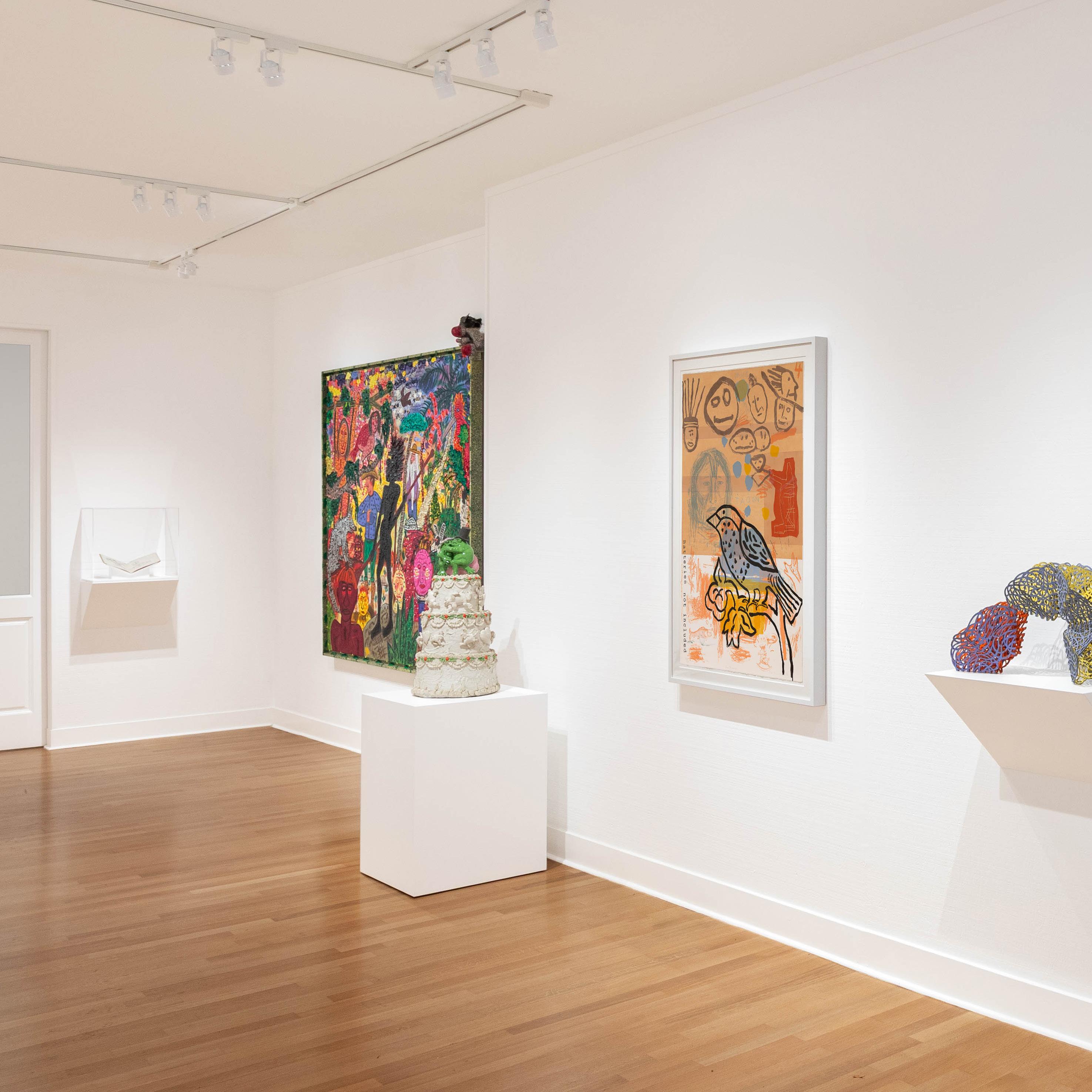

Attributed to John Trumbull (American, 1756-1843)
Last Supper
c.1770-1780
oil on panel
10 1/2 x 8 inches
Provenance
By decent to Trumbull Higgins, New York, NY
Private Collection, Berkeley, CA
871 Fine Arts, San Francisco, CA
Private Collection, San Francisco, CA
Notes
John Trumbull was an American painter and military officer from the Revolutionary war period. In 1780, he travelled to London to study under the well-known painter Benjamin West. Trumbull is best known for his portraits and images of the American Revolutionary war. His painting of the Declaration of Independence and three other paintings of the revolutionary period were purchased by the United States Congress and currently hang inside of the U.S. Capital rotunda in Washington D.C. This painting of the Last Supper of Christ is attributed to him and is considered a student work. One of the indications of it being created while he was a student is the anatomy of the figure standing on the left side of the composition is not entirely anatomically correct in its posture.


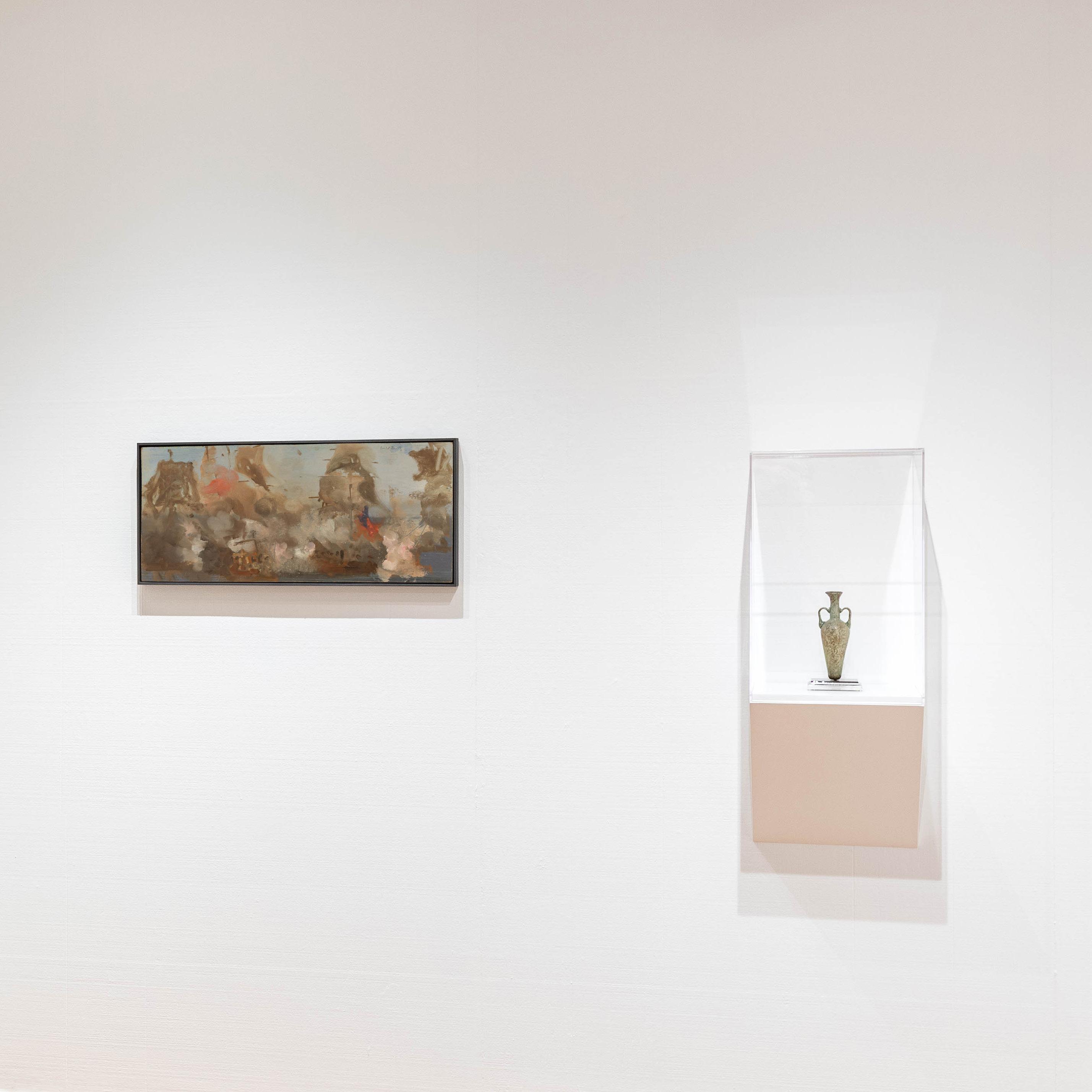
Nicoya
Culture, Guanacaste, Costa Rica
Shaman Effigy Tripod Vessel
n.d.
painted ceramic
13 3/4 x 11 x 11 3/4 inches
Provenance
Private Collection Notes
The Kingdom of Nicoya (from Nahuatl: Nekok Yaotl), also called Cacicazgo or Lordship of Nicoya, was an indigenous nation that comprised much of the territory of the current Guanacaste Province, in the North Pacific of Costa Rica. Its political, economic and religious center was the city of Nicoya, located on the peninsula of the same name. In the 16th century, prior to the arrival of Europeans, Nicoya was the most important chiefdom of the North Pacific region in present-day Costa Rica.
This pear-shaped pottery vessel portrays a shaman transformed into his/her jaguar alter ego. The fierce spirit erupts from the jar, jutting its feline head out through a dark rayed circle, with gaping mouth and teeth bared ready to attack. Small pellets inside the hollow front legs produce a rattling sound when the vessel is moved, recalling the low grumble of the jaguar as it stalks its prey. The shaman’s human form is conveyed by the jaguar’s vertical attack pose which mimics that of his/her conventional position seated on a low stool and with hands resting on the knees. The sensation of loss-of-body, typical of the shaman’s visionary experience, is evoked by the black-painted limbs and head seemingly disembodied by the stark white background on which the limbs float in a featureless void. Tiny profile jaguars adorn the black-painted limbs in contrast to the human forms surrounding the opening through which the jaguar thrusts its head. These tiny figures echo the jar’s theme of the human shaman residing within the visionary jaguar.

Robert M. Kulicke (American, 1924-2007)
Flower Still Life
1960 oil on board
7 3/4 x 8 1/2 inches
Provenance
Collection of Allan Stone, New York Estate of Allan Stone, New York Private Collection, California

David Fertig (American, born 1946)
Battle of the Nile
n.d.
oil on Masonite
13 x 29 1/2 inches
Provenance
Artist’s Studio
Private Collection
Auction
Private Collection, New York
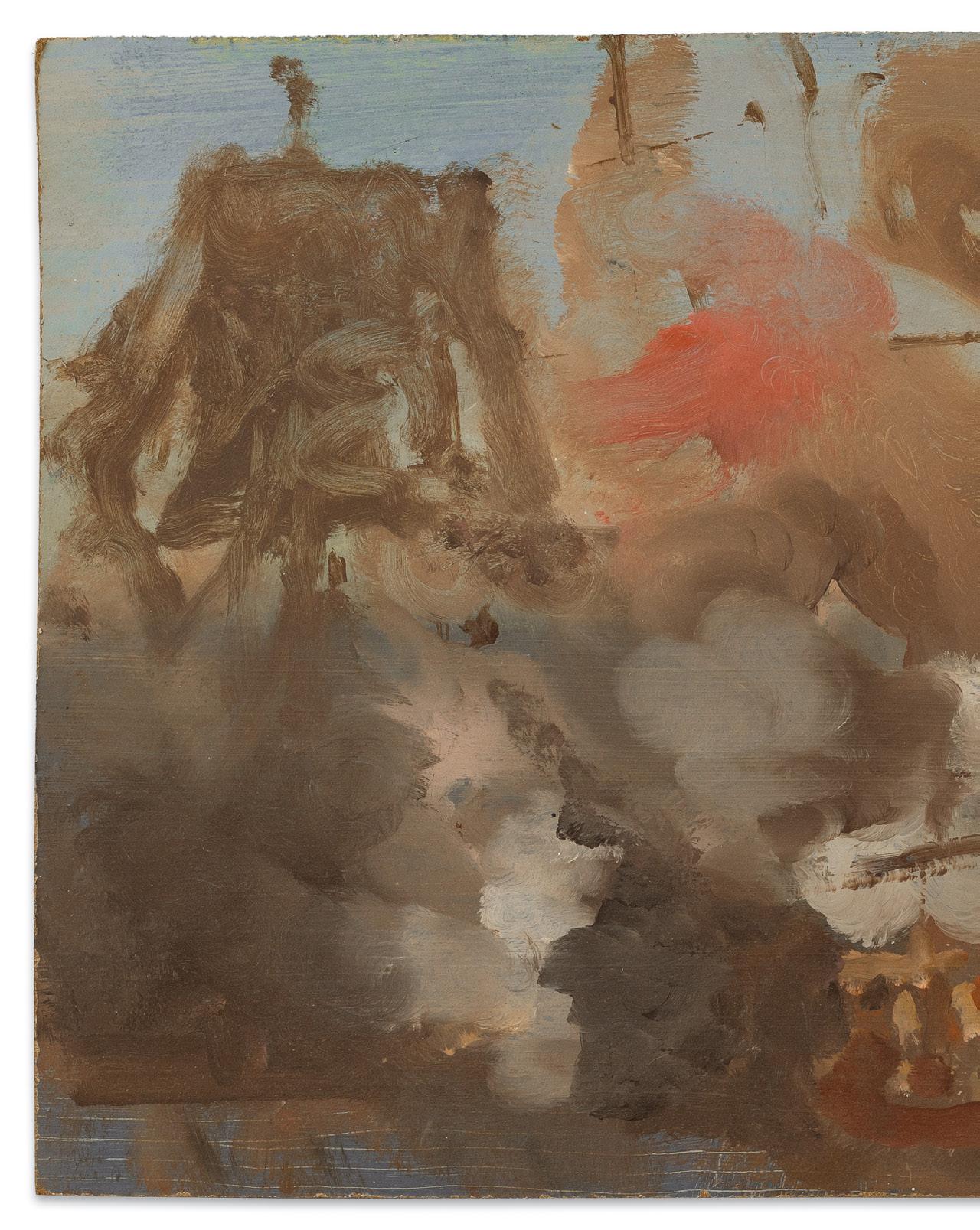

Roman Culture
Roman Green Glass Amphoriskos
c.1st-3rd Century AD green glass
8 3/8 x 3 3/4 x 4 1/4 inches
Provenance
Private New York Collection
Art for Eternity, New York, NY
Private Collection
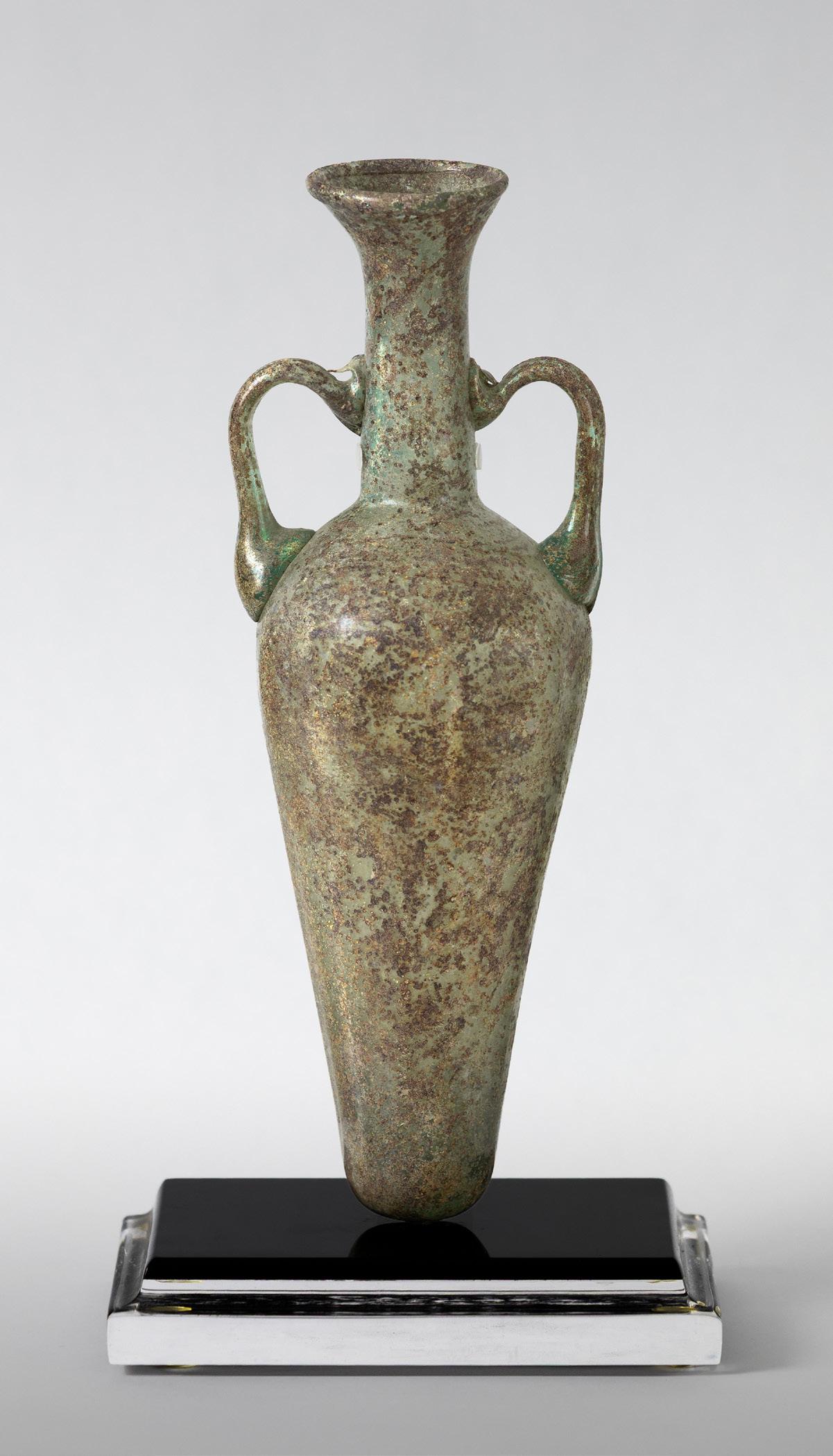


Fred
Dalkey (American, born 1943)
Still Life with Skull
oil on linen mounted on panel 11 5/8 x 14 7/8 inches
Provenance
Artist’s Studio
Private Collection, California
Elliot Fouts Gallery, Sacramento, CA
Private Collection, San Francisco, CA


Carlos Villa (American, 1936-2013)
Waikiki (Little Wave)
1972
acrylic on rough canvas with strips of feathers, nails, mirror, and blood approx. 94 x 94 x 3 inches
Provenance
Artist’s Studio
Hansen Fuller Gallery, San Francisco, CA
Private Collection, San Francisco, CA
Notes
Carlos Villa returned to San Francisco from New York in 1969 after having spent five hears there after receiving his MFA from Mills College in Oakland, CA. While in New York, Villa had gotten to know many of the avant garde artists in the city, including Mark Rothko, and witnessed the birth of many of the modern art movements regarded as canonical to American art in the 20th century. Near the end his time there, however, Villa became disillusioned with the precepts and principles of modern art. Villa found that modern art did not resonate with his Filipino American identity, and he began to wonder what art existed outside of the European/American western canon. What began for Villa was a journey of discovery about the art made outside the western world – African, Mesoamerican, and Oceania.
Villa was aided in his quest by Thomas Seligman, who had been hired by the De Young Museum in San Francisco to establish a new department for the arts of Africa, Oceania, and the Americas. Villa’s explorations led him to both a positive self-identity and artistic identity, as well as a broad sense of what constituted his own heritage. With a focus on tribal and ethnographic sources, Villa would draw inspiration for his works from across a diverse array of sources.
The first significant body of work to arise from this new perspective as an artist were Villa’s featherworks – capes, coats, shoes, masks, headdresses, and other objects. Waikiki (Little Wave), 1972, is a prime example from this period of his work. Composed of acrylic paint, nails, feathers, mirror shards, and animal blood on canvas, the cape feels as if it could be an aerial map in addition to being a ceremonial robe. “Villa later spoke on several occasions of his interest during this time in the idea of artist as shaman. Having gained notoriety for his work with feathers, he explained, ‘I use feathers because they break up an area in a certain kind of way. I like the way the feathers feel to me visually. Because when I look at my work, I like to touch my work with my eyes. And so there’s just something about the visual chemistry of what a feather does – or what feathers do – to a certain kind of surface’” 1 Villa tailored the size and shape of his capes and coats to his body and at times would wear them for performances.
1

Alfred Leslie (American, 1927-2023)
Untitled 1957
mixed media on paper
17 1/2 x 14 5/8 inches
Provenance Collection of Allan Stone, New York Estate of Allan Stone, New York Private Collection, Berkeley, CA
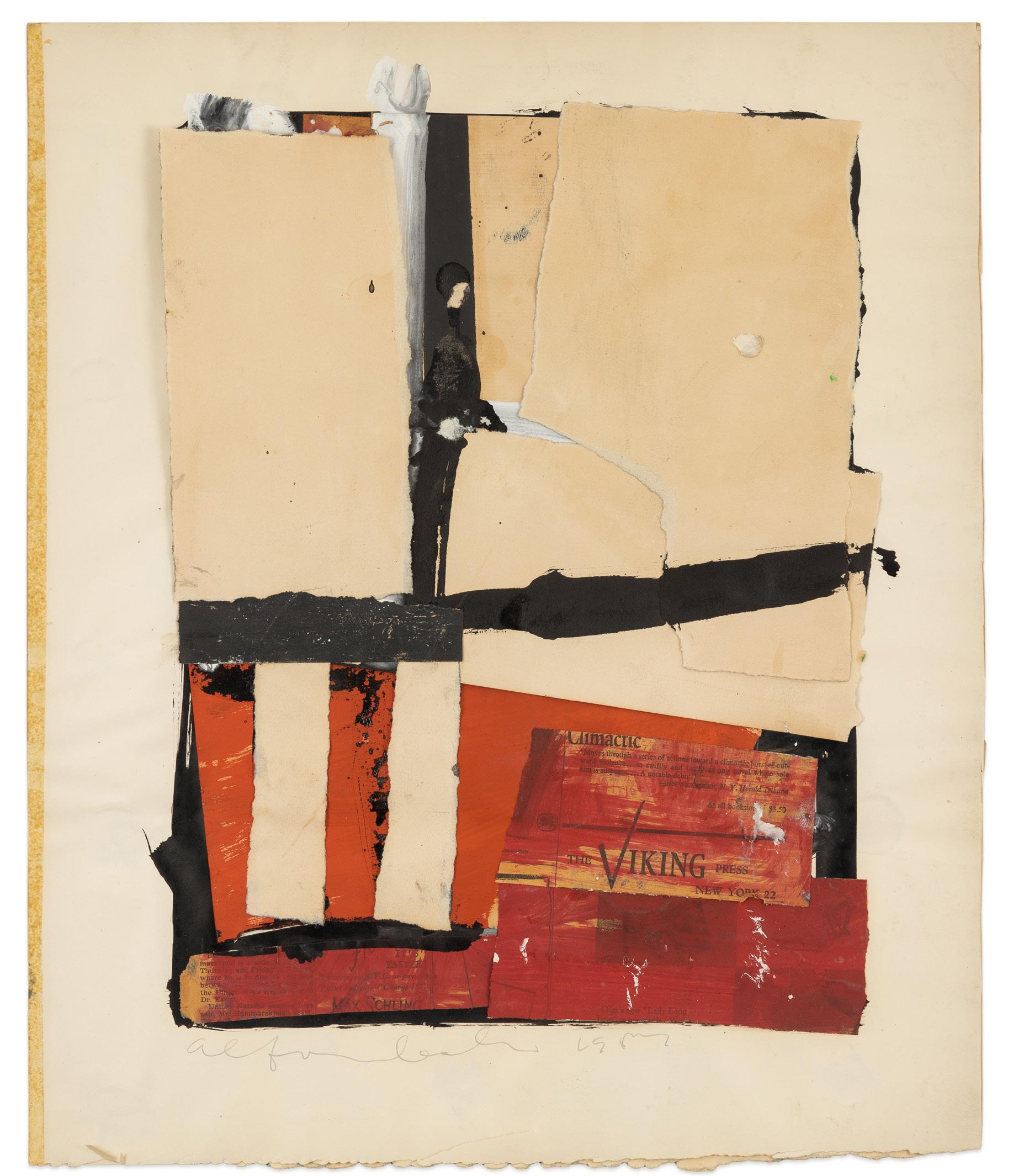


Ed Musante (American, 1942-2022)
Rooster/ Gabler’s Judge
n.d.
mixed media on cigar box
8 3/8 x 4 15/16 x 1 3/8 inches
Provenance
Acquired directly from the Estate of Ed Musante
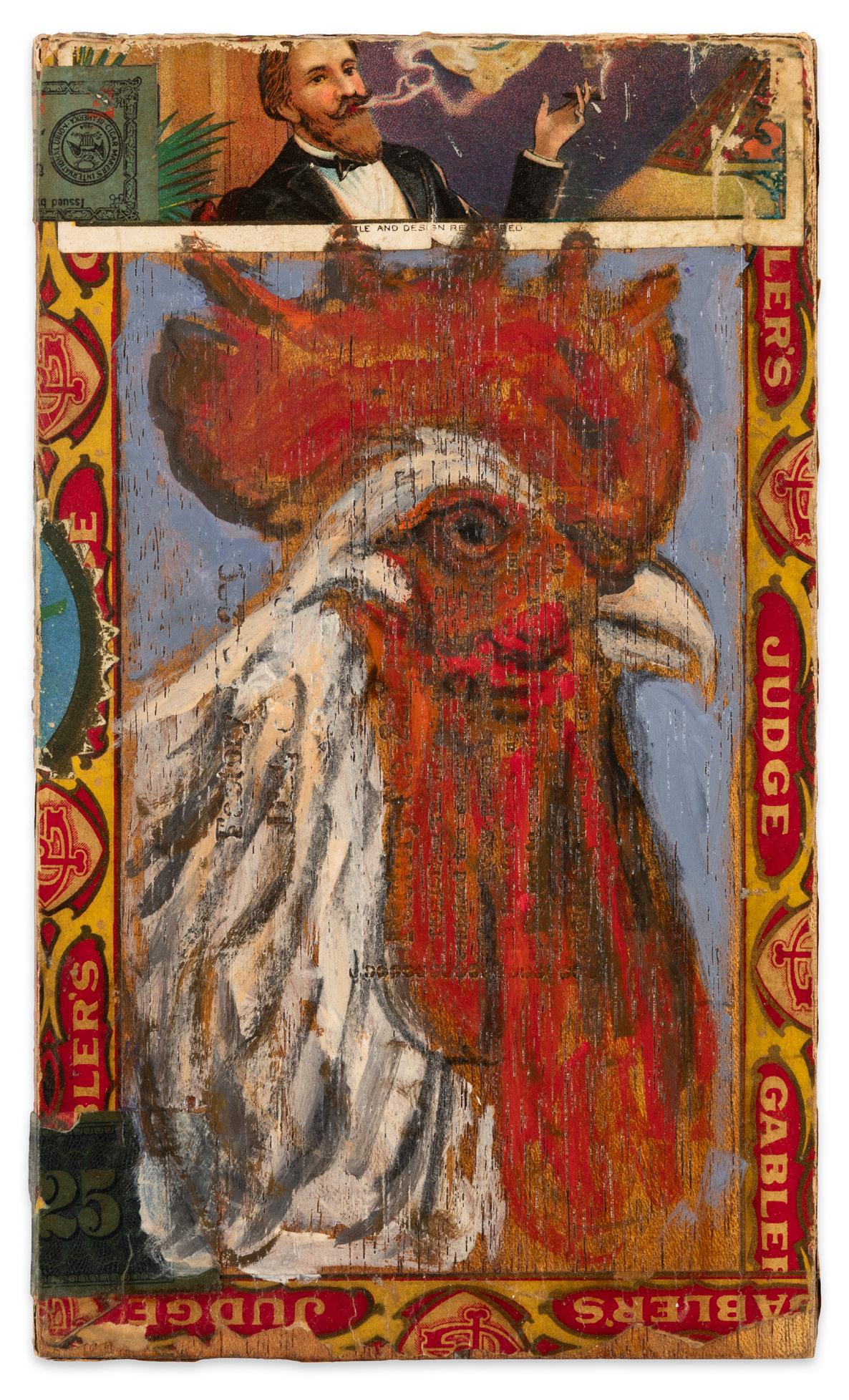
Andrew I. Wilson (American; Member of the Cherokee Nation, born 1991)
One Day You’ll Become Rain
2025
cyanotype on cotton, toned, hand quilted
69 x 55 inches
Provenance
Acquired directly from the artist
Notes
The title of Andrew Wilson’s One Day You’ll Become Rain comes from Michelle Wright’s book Physics of Blackness: Beyond the Middle Passage Epistemology, and refers to precipitant time or the amount of time an atom takes to fall out of a solution. Wright extrapolated this concept in thinking about the African peoples who were either pushed over or jumped over the sides of slave ships during the middle passage and their bodies became part of the waters of the Atlantic. In her thinking, their bodies will eventually be returned to the land in both a literal manner thought the movement of atoms, but also in a spiritual way for their souls.
The quilt is made from cotton scraps, which come from other projects in Wilson’s studio, as well as cyanotype printed cotton containing the image of the Brookes slave ship. Andrew Wilson views this quilt and its sister Muddy Water/Pot liquor, which was shown in the 2023 edition of Twenty-Five Treasures, as maps of a non-specific nature that guide those who were lost to the sea back to us.

Makonde Culture, Southern Tanzania
Pregnant Female Mask
n.d.
carved darkened wood
20 x 9 1/2 x 6 inches
Provenance
Merton D. Simpson Gallery, New York, NY
Private Collection
Notes
The Makonde people live in southeast Tanzania, northern Mozambique, and Kenya. This Makonde body mask, known as a njorowe, is from Tanzania. Masks like this one are used in Makonde initiation rituals. During their initiation, boys are isolated for a period of several months during which they are circumcised and taught rules of adult behavior, expectations of married life, traditional songs and dances, and other practical skills. When the young men return to the village, celebrations including masked dance performances are held. A male dancer wears this type of body mask along with a feminine mask on his face, representing a young, pregnant woman. Together with a male masked figure, the dancers pantomime sexual intercourse and demonstrate the burdens of pregnancy and agony of childbirth. The ritual prepares young men and women for their roles as future husbands and wives.
The belly of this mask features incised designs. On a person, these designs are created by incisions in the skin that are rubbed with vegetable carbon and then castor oil to create a dark blue color. The result is somewhere between scarification and a tattoo. The Makonde believe that tattoos near the navel protect against evil spirits. Historically, many Makonde people had facial tattoos, but they are rare today.
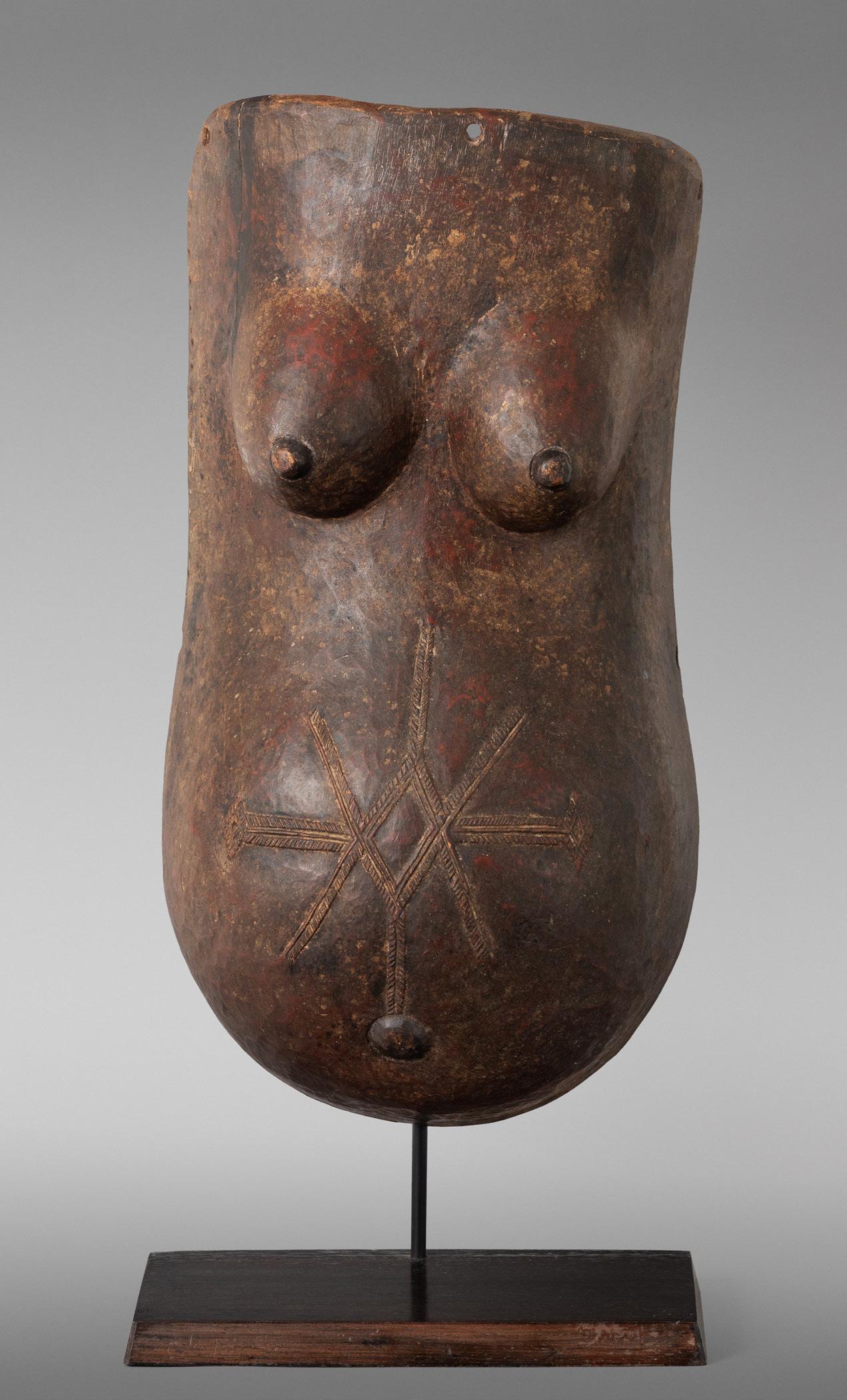
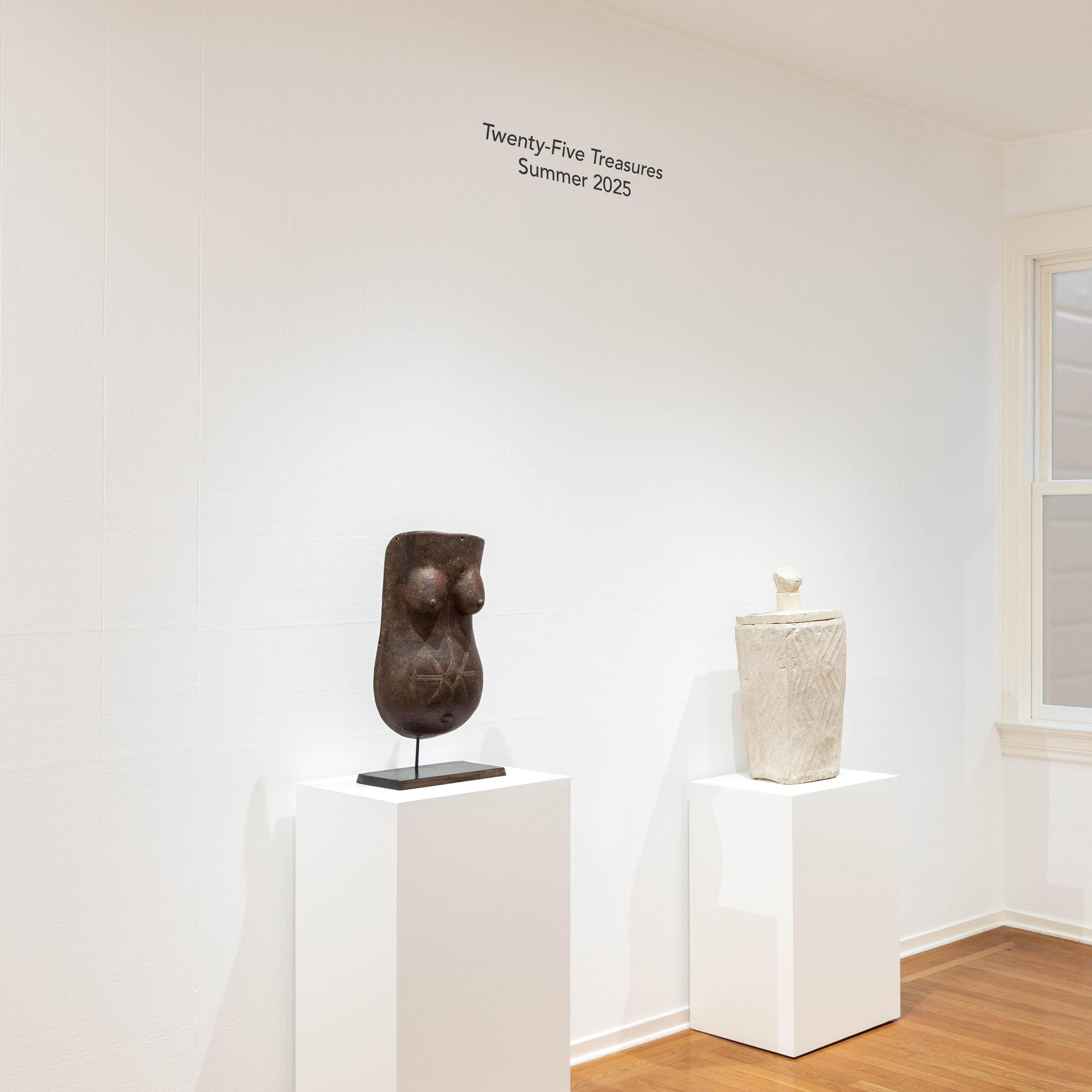

Salangsang Culture, Mindanao, Philippines
Covered Burial Jar
c. 600 A.D.
carved limestone ossuary
27 1/2 x 9 1/2 x 9 1/2 inches
Provenance
Collection of John A. Williams and Dewitt Hart, acquired in the 1970s Estate of John A. Williams San Rafael Auction Gallery, April 27, 2024 (Lot 0285) sold Private Collection, San Francisco, CA
Notes
Barangay Salangsang is considered a part of the Kulaman plateau on the island of Mindanao in the Philippines. In 1967 the region was proclaimed a reservation for the indigenous mountain tribes - the Manobò and Tiruray (also known as Teduray) peoples. About 500 Manobò families and a large number of Tiruray inhabited the region at the time of the proclamation and they have remained there since. At around the time of the reservation’s creation, the caves and rock coverings where this burial jar comes from were first discovered. The full history of these burial jars is not known, however the use of burial jars throughout the Philippines is common among the indigenous tribes to this day. Most ancient burial jars from the Philippines are made from fired clay, however those from the Salangsang are unique for being made from carved limestone.
This burial jay displays geometric designs made from parallel grooves cut into all four sides of the vessel section. The lid of the jar displays similarly cut parallel grooves and an anthropomorphized head carved into the handle. The face is defined by two identical smooth planes for cheeks separated by a distinctly carved nose shape made from a arched ridge. Below these features is a small slit forming the mouth. The cheeks also hint at the lid possibly having been painted in polychrome at one point. These traits often appear on the lids of burial jars from the region, but not always. Given its size, it can be inferred that this jar was used for the secondary burial of the bones of the deceased, after the primary burial in either the ground or trees was completed.

Donna Brookman (American, born 1949)
Rift 2014
acrylic on linen
104 x 56 inches
Provenance
Acquired directly from the artist
Notes
A celebrated painter from the San Francisco Bay Area, Donna Brookman’s career has spanned over 40 years in painting. Her Palace of Memory Series, which Rift is a part of the Glacis/Rune subseries, was inspired by the haunting environmental destruction she witnessed when she visited India in 2013. Returning from this trip, she felt as if systems were collapsing and the world was coming apart.
Intuitive in her choices of color and the application of her brushstrokes, Brookman finds that each of her paintings reveal themselves as she creates it. The flowing drips of white and silver paint recall the splitting of ice as a glacier melts away. The pillar like forms central to the composition also form a portal through which the viewer can metaphorically enter into the unknown future ahead of us. Rift is among the first works Brookman painted in this series. Its monumental size was intentionally chosen to make the view feel small when confronted with its physical presence, a reminder to us that we should be both humble and responsible to the natural world around us.



Exhibition Checklist
Anonymous, Kota, Rajputana, India (cat. no. 6)
Members of the Court of Ram Singh II
c. 1830
ink on paper
14 1/8 x 10 1/4 inches
Courtesy Private Collection
Ruth Asawa (cat. no. 4)
Untitled (S.636, Hanging Open-Window Form with Seven Tiers)
c. 1950s
looped steel wire
40 1/2 x 15 x 15 inches
Courtesy Private Collection
Harry Bowden (cat. no. 2)
Horizontal
c. 1938
oil on paper
8 x 12 inches
Courtesy Private Collection
Donna Brookman (cat. no. 25)
Rift 2014
acrylic on linen
104 x 56 inches
Fred Dalkey (cat. no. 18)
Still Life with Skull
1994
oil on linen mounted on panel
11 5/8 x 14 7/8 inches
Roy De Forest (cat. no. 9)
Tropic of Capricorn
1999-2000
acrylic on canvas with sculptural appendage
84 x 90 1/2 x 8 inches
David Fertig (cat. no. 16)
Battle of the Nile
n.d.
oil on Masonite
13 x 29 1/2 inches
Linda Fleming (cat. no. 12)
Wave
2017
acrylic on laser cut plywood
13 x 21 x 9 inches
David Gilhooly (cat. no. 10)
Erotic Frog Wedding Cake #6
1979
glazed and painted earthenware
28 1/2 x 14 1/2 x 14 1/2 inches
Courtesy Private Collection
Shawn HibmaCronan (cat. no. 1)
Ground Looper 2022
stainless steel, bicycle tires, fiberglass Eames chair, 3D printed bird skull
90 x 26 1/2 x 49 inches
Franz Josef Kline (cat. no. 8)
Sketchbook (from London)
n.d.
clothbound book
5 1/4 x 7 1/4 inches
Robert M. Kulicke (cat. no. 15)
Flower Still Life
1960
oil on board
7 3/4 x 8 1/2 inches
Alfred Leslie (cat. no. 20)
Untitled
1957
mixed media on paper
17 1/2 x 14 5/8 inches
Exhibition Checklist (cont.)
Makonde Culture, Mueda Plateau, Southern
Tanzania (cat. no. 23)
Pregnant Female Mask n.d.
carved darkened wood
20 x 9 1/2 x 6 inches
Courtesy Private Collection
Giorgio Morandi (cat. no. 5)
Natura Morta
1956
oil on canvas
7 7/8 x 10 1/4 inches
Ed Musante (cat. no. 21)
Rooster/Gabler’s Judge n.d.
mixed media on cigar box
8 3/8 x 4 15/16 x 1 3/8 inches
Manuel Neri (cat. no. 7)
Untitled (Standing Female Figure)
1987
plaster, burlap, acrylic, wood, styrofoam, and steel
70 3/4 x 26 1/4 x 17 1/2 inches
Nicoya Culture, Guanacaste, Costa Rica (cat. no. 14)
Shaman Effigy Tripod Vessel n.d.
painted ceramic
13 3/4 x 11 x 11 3/4 inches
Courtesy Private Collection
Roman Culture (cat. no. 17)
Roman Green Glass Amphoriskos
c. 1st-3rd Century AD
green glass
8 3/8 x 3 3/4 x 4 1/4 inches
Courtesy Private Collection
Salangsang Culture, Mindanao, Philippines (cat. no. 24)
Covered Burial Jar
c. 600 A.D.
carved limestone ossuary
27 1/2 x 9 1/2 x 9 1/2 inches
Courtesy Private Collection
Jaune Quick-To-See Smith (cat. no. 11)
Four Directions
1994
photolithograph and linocut, ed. 26/100
44 1/2 x 30 inches
Wayne Thiebaud (cat. no. 3)
Cityscape
1993
oil on wooden box
7 5/8 x 4 x 3 inches
Courtesy Private Collection
Attributed to John Trumbull (cat. no. 13)
Last Supper c. 1770-1780
oil on panel
10 1/2 x 8 inches
Courtesy Private Collection
Carlos Villa (cat. no. 19)
Waikiki (Little Wave) 1972
acrylic on rough canvas with strips of feathers, nails, mirror, and blood approx. 94 x 94 x 3 inches
Andrew I. Wilson (cat. no. 22)
One Day You’ll Become Rain
2025
cyanotype on cotton, toned, hand quilted
69 x 55 inches
Lenders
Private Collection, Berkeley, CA
Private Collection, California
Private Collection, New York, NY
Private Collection, Oakland, CA
Private Collection, Palm Desert, CA
Private Collection, San Francisco, CA
Copyright 2025 Paul Thiebaud Gallery. All rights reserved.
Design: Greg Flood and Matthew Miller. No portion of this document may be reproduced or stored without the express written permission of the copyright holder(s).
Images
pg. 9 - Copyright 2025 Shawn HibmaCronan, photo: Matthew Miller. photo: courtesy of the artist.
pg. 13 - Copyright 2025 Estate of Harry Bowden, photo: Matthew Miller.
pg. 15 - Copyright 2025 Estate of Wayne Thiebaud / Licensed by VAGA at Artists Rights Society (ARS), NY., photo: Matthew Miller.
pg. 17 - Copyright 2025 Ruth Asawa Lanier, Inc., photo: Matthew Miller.
pg. 19 - Photo Copyright 2025 Imogen Cunningham Trust; Artwork Copyright 2025 Ruth Asawa Lanier, Inc., photo: courtesy of Imogen Cunningham Trust.
pg. 23 - Copyright 2025 Estate of Giorgio Morandi / Artists Rights Society (ARS), NY., photo: Matthew Miller.
pg. 27 - Copyright 2025 Estate of Manuel Neri, photo: Matthew Miller.
pg. 33 - Copyright 2025 Estate of Franz Kline / Artists Rights Society (ARS), NY., photo: Matthew Miller.
pgs. 34-35 - Copyright 2025 Estate of Roy De Forest / Licensed by VAGA at Artists Rights Society (ARS), NY., photo: Matthew Miller.
pg. 39 - Copyright 2025 Estate of David Gilhooly, photo: Matthew Miller.
pg. 41 - Copyright 2025 Estate of Jaune Quick-To-See Smith, photo: Matthew Miller.
pgs. 42-43 - Copyright 2025 Linda Fleming, photo: Matthew Miller
pg. 53 - Copyright 2025 Estate of Robert M. Kulicke, photo: Matthew Miller.
pgs. 54-55 - Copyright 2025 David Fertig, photo: Matthew Miller
pgs. 60-61 - Copyright 2025 Fred Dalkey, photo: Matthew Miller.
pg. 63 - Copyright 2025 Estate of Carlos Villa, photo: Matthew Miller.
pg. 65 - Copyright 2025 Estate of Alfred Leslie, photo: Matthew Miller.
pg. 69 - Copyright 2025 Estate of Ed Musante, photo: Matthew Miller
pg. 71 - Copyright 2025 Andrew I. Wilson, photo: Matthew Miller.
pg. 79 - Copyright 2025 Donna Brookman, photo: Matthew Miller.
Image Credits
pgs. 6-7, 10-11, 20-21, 25, 30-31, 36-37, 44-45, 47-49, 51, 57-59, 66-67, 73-75, 77, 80-81 photo: Matthew Miller
pgs. 28-29 - photo: courtesy private collection.
